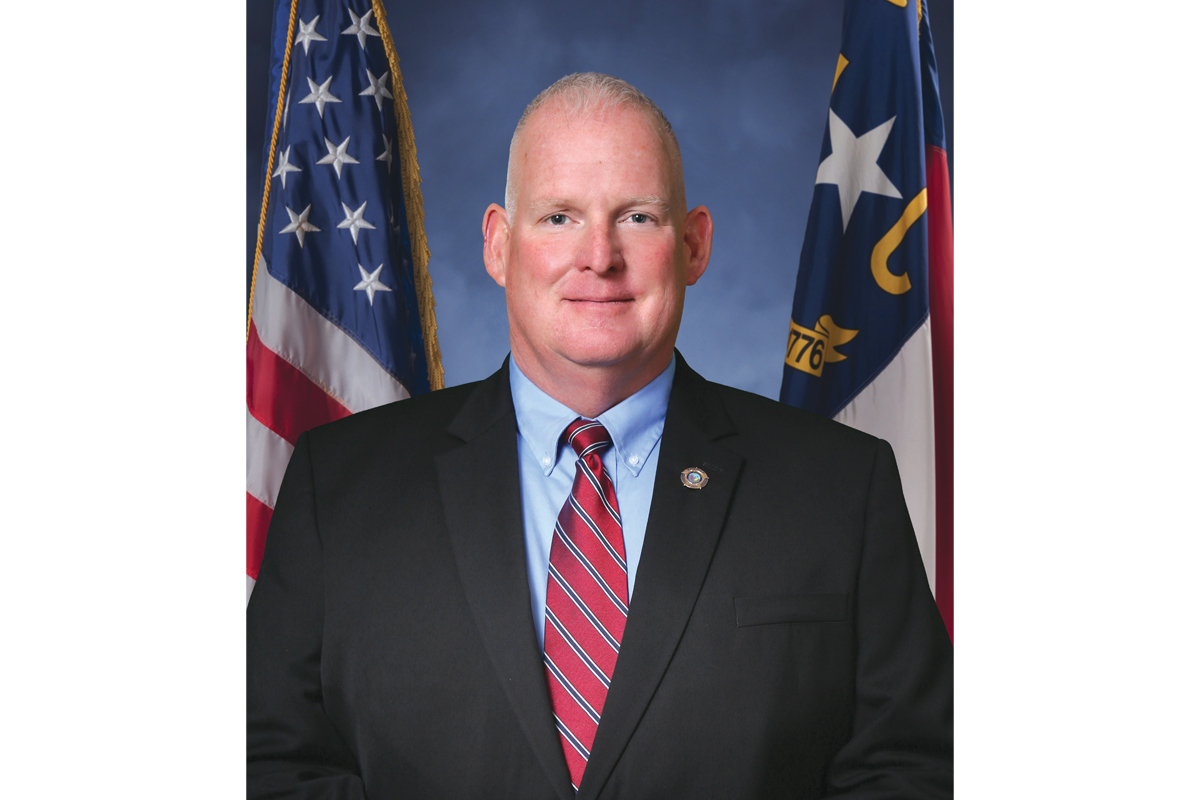The state of the sheriff’s office: Haywood’s top cop drops data, details from his first year
 Haywood County Sheriff Bill Wilke was sworn in last December. File photo
Haywood County Sheriff Bill Wilke was sworn in last December. File photo
It’s been just under a year since Bill Wilke became Haywood County’s sheriff, after longtime popular incumbent, Greg Christopher, decided to call it a career.
Now that Wilke’s got some time under his belt, he’s touting the accomplishments of his office in quantitative and qualitative ways that will set the baseline for next year.
“I just wanted to give you an overview of what we’re doing with county resources,” he told Haywood County commissioners on Nov. 20.
One of the biggest achievements since Wilke’s been in office — although not strictly his alone — was the expansion of the county’s school resource officer program. Last year, there were only seven SROs rotating between the county’s 15 public schools, leaving a critical gap in protection and a better than 50/50 chance that a school shooter wouldn’t encounter an armed law enforcement officer on school grounds.
But SROs aren’t free, and Haywood County residents don’t like tax increases, so that’s where the issue remained for nearly a decade until Wilke showed up at a commission meeting on May 15 to sell the idea of a 1.5-cent property tax increase to fund eight additional SROs. In context, the tax increase meant that a homeowner with a $250,000 property paid an additional $37.50 on top of their annual $1,337.50 tax bill.
Commissioners incorporated the $1.48 million request into the county’s annual budget, while generally expressing disdain for the tax increase but enthusiastically supporting the reason behind it. Even Commissioner Terry Ramey, who has a long history of unpaid property taxes and still owes the county nearly $2,000, voted for it.
Related Items
Wilke not only had to sell the idea, he also had to staff the positions.
“We need someone that’s capable of responding to a shooting incident and being willing to look at another human being and, in defense of six- to 12-year-old kids, shoot that person dead,” he told commissioners at the time.
Overall, Wilke said, turnover in the office has slowed. Right now, he has two vacancies in the jail, two in operations, two in the crime scene unit and one in criminal investigations. Wilke was “cautiously optimistic” that the office would be at full strength by June. With the numbers his office has been logging, he’ll need every position staffed.
For a 304-day period from Jan. 1 through Oct. 31 of this year, the sheriff’s office logged 24,322 calls for service, almost exactly 80 per day or 3.3 every hour. Suspicious vehicles accounted for 648 of them, 723 were for suspicious persons, 794 we for domestic disturbances, 913 were for welfare checks and 1,327 were for extra patrols.
When services were dispatched, 54% were law enforcement officers, 24% were EMS and 22% were firefighters.
A lot the of credit for handling the calls goes to 911 Dispatch Manager Chanda Morgan, who in May was recognized as North Carolina’s communications director of the year.
More than 3,600 calls taken during the period mentioned by Wilke were about civil process service, with 2,150 sets of papers served.
Throughout the 2022 campaign, Wilke and his Primary and General Election opponents all talked about the importance of civil process service — an overlooked but vital part of the job.
For deputies, Wilke’s office has stressed training, much of it collaborative in nature. This year, HCSO has conducted or participated in active shooter training with EMS at Tuscola High School, SWAT training with the Waynesville Police Department and drone operations with EMS and the SRT.
The combined drone program was first used earlier this year during an active shooter standoff on Prevost Street. Wilke said that two drones were deployed continuously, watching the suspect through the window of the building he occupied.
Wilke also said that every deputy has completed or would soon complete crisis intervention training.
“In a word, it’s de-escalation,” he said. “What that is really is a commitment on our part to ensure that those who are suffering a mental health crisis, when they encounter the police, our first commitment is to take the time and to take the resources to first address their needs.”
He also lauded a reintegration programs manager hired in May, Bob Cummings. Cummings’ main job is to provide support for inmates who are less likely to become recidivists. The local faith community has also played a significant role in Cummings’ success.
Commission Chairman Kevin Ensley asked Wilke if he needed more people like Cummings, whose work Wilke described as “promising.” Wilke said the role is still evolving, but that it was likely he would.
“I appreciate you continuing the faith-based programs, because they work,” Ensley said.
The criminal investigation division was also busy, issuing 80 arrest warrants, 35 of which were search warrants resulting in the recovery of more than $870,000 in stolen property.
HCSO’s K-9 program expanded from four to six dogs, who searched 57 vehicles and went through almost 500 hours of training with handlers.
“We have a dog accessible 24/7, and it’s vital to our interdiction efforts,” Wilke said.
And Wilke’s drug interdiction efforts have indeed garnered notice.
On April 28, deputies with the narcotics and interdiction unit conducted an investigation that resulted in the pursuit and arrest of an Asheville man on charges of fleeing, trafficking and possession of a firearm by a felon. Seized during the arrest was 497 grams of methamphetamine and what’s likely the largest fentanyl bust in recent county history, almost 300 grams.
“There is no way to estimate the number lives that keeping this amount of suspected fentanyl and methamphetamine from reaching our county has saved,” Wilke said in a Facebook video the next day. “If you haven’t heard me before, hear me now — if you sell, transport or deliver drugs, your freedom to operate in Haywood County is over. We will find you, we will charge you and ensure that you spend as much time behind bars as possible. That’s a promise.”
The bust contributed to the substantial amount of drugs seized during the first nine months of the year, including 43 grams of crack cocaine, 241 grams of cocaine, 315 grams of cannabis, 56 units (usually pills) of morphine, 27 grams and 100 units of opium, 20 grams of heroin, 3,270 grams of meth, 88 units of barbiturates and a smattering of other controlled substances.
Wilke’s office also seized a whopping 963.4 grams of fentanyl — more than two pounds and enough to kill nearly every single person from Asheville to Murphy. The numbers are all the more staggering considering they’re only from a rural county of 60,000 people.
“I have a tough guy sheriff’s approach and I mean every word of that,” Wilke said. “And some folks are getting the message.”
Commissioners Tommy Long and Brandon Rogers asked Wilke if he had data for previous years to compare, but Wilke said it wouldn’t be a fair comparison, because he has a different team and a different focus — more on trafficking, while previous efforts were directed at the user level.
Wilke did say that he believes that by the end of the year, numbers will be significantly higher than last year, and that this was only the beginning of his efforts.
“My plan is to have that data for you next year,” Wilke said.









